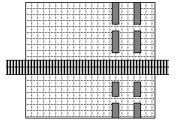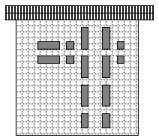FRtR > Essays >
The Iron Horse >
Town Shapes
The Iron Horse: the impact of the railroads on 19th century American society
18/30 (IV) Colonizing the West: Town Shapes
By Marieke van Ophem
*** Index
* < Previous page
* Next page >
***
Even within the rigid grid pattern they all followed, there was considerable variety in
railroad town plats. Town shapes developed in a way that showed experience determined
which shape functioned best. The earliest conception was a parallel arrangement with the
railroad track as the axis of symmetry. It had always been commonplace for businesses to
face the artery of commerce, whether that was a road, a canal or a waterfront. Perhaps the
railroads were imitating that layout. This arrangement created two business streets, with
buildings facing each other across 300 feet of railroad right-of-way. The wide strip
provided room for elevators, coal yards, and other businesses that needed direct access
to the railroad. Rarely both railroad-facing business streets developed equally; if First
Avenue North was the major concentration, then First Avenue South became "the other (or
the wrong) side of the tracks" with a row of saloons and cheap motels. A strip of land the
size of a football field separating the business district kept it from developing as a single unit.

symmetric town (explanation)
Placing businesses on both sides of the same street made more sense,
and this arrangement soon gained preference. In most cases the business street crossed the
railroad tracks at an angle, so that only one crossing was necessary between the two parts
of the commercial district. The tracks bisected Main Street; thus the form was orthogonal.
The train depot was generally located near this crossing. But still towns continued to develop
more on one side of the tracks than on the other, and the orthogonal plan soon evolved into
its final phase, the T-town. In this arrangement, the town itself was built on just one side
of the tracks, with Main Street at a straight angle. This was a stable solution, more acceptable
to the railroad and the townspeople. It became popular in the late nineteenth and early twentieth
centuries- the final phase of US railroad building, when railroad towns were built mainly along
branch and subsidiary lines. But it was dominant in the Canadian West, where the railroad building
phases took place about two decades later.


orthogonal town
T-town
In the long run, the success of a town was determined by the shifting conditions of retailing
and marketing. A developing business class would bring life to a town and contribute to funneling
traffic to the railroad, as was the intention of the railroad company. This, in effect, had a
democratizing influence, by allowing people with little capital to start a business. Many who
did that grew discontented, and soon became community leaders. They bundled their strengths,
founded stronger financial institutions, and bought out weaker competitors. This behavior was
applauded by railroad officials, despite the fact that such economic evolution was a result of
actually surviving the railroad's blueprint for settlement.
Most railroad towns were failures. They could not keep their heads above water when in the
1920's technological changes began making small towns obsolete. This is especially true for
the towns built during the wave of railroad building between 1905 and 1915. These static towns
were unfit for a world in constant motion. If the railroads had played a less active role in
creating towns, there probably would have been a greater variety in towns and cities. The urban
geography of the West may have had a much different appearance than it does today.
*** Index
* < Previous page
* Next page >
***

